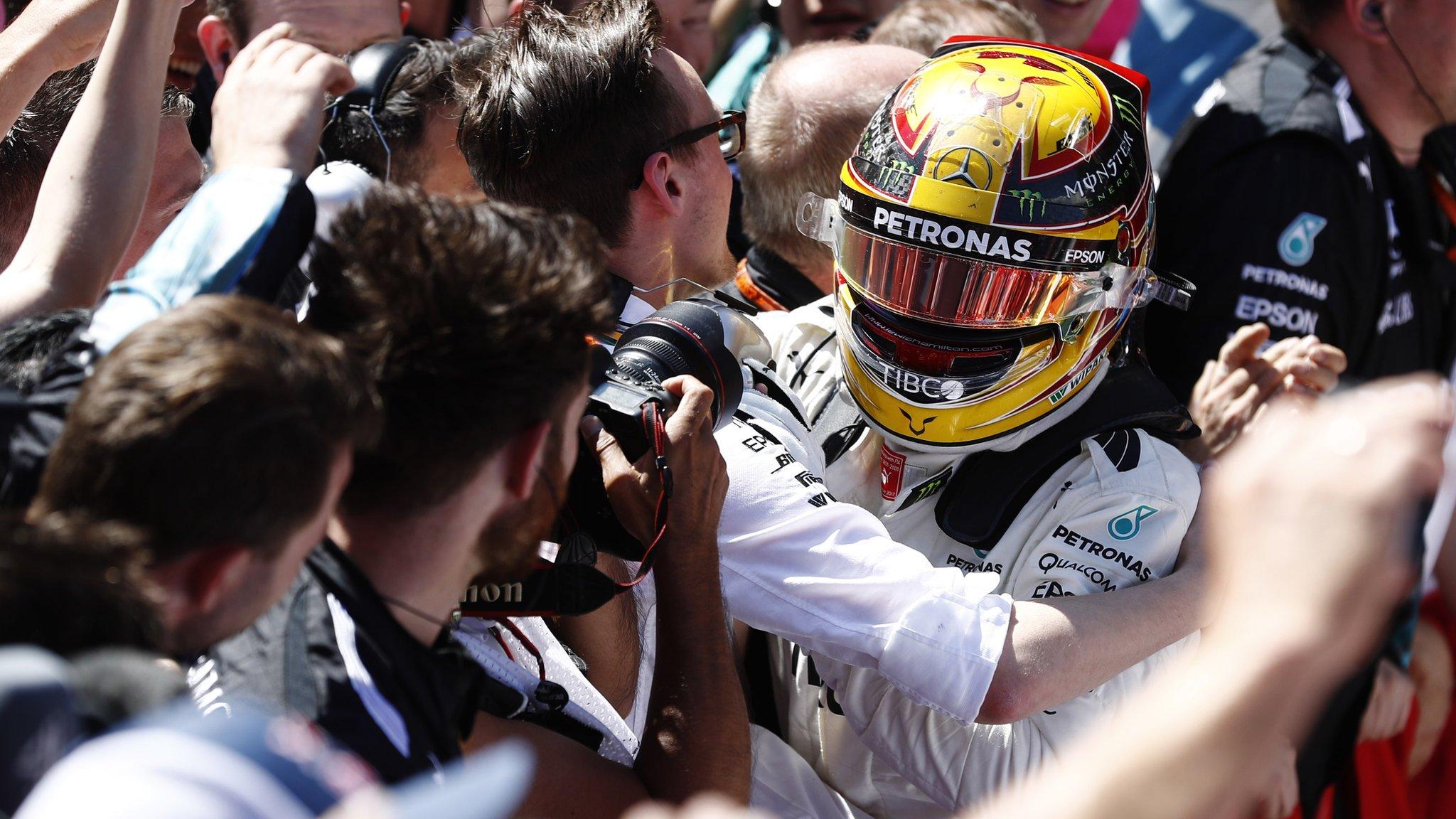Lewis Hamilton & Sebastian Vettel provide 'a scrap between two of the greatest'
- Published
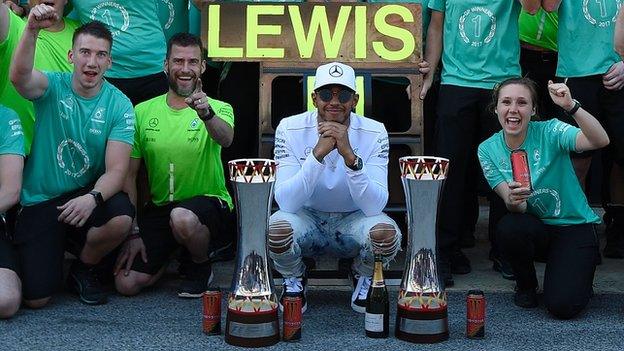
Hamilton's win closed the gap to Sebastian Vettel in the championship standings to six points
The sense of satisfaction oozed out of Lewis Hamilton after the Spanish Grand Prix, in which he took a thrilling victory in the best race of a season that is already heading towards becoming a classic.
The Mercedes driver's 55th career win meant he matched title rival Sebastian Vettel on two wins each in the five races so far this season and closed the points gap at the top of the championship to just six heading into the next race in Monaco on 28 May.
Just as importantly, it was a victory to boost the confidence of both Hamilton and his team. They did it the hard way after losing the lead to Vettel on the first lap, and it required both brilliant driving and inspirational strategic thinking to get back past the Ferrari.
The effort it took from Hamilton was apparent by the unusual breathlessness of many of his radio messages as he and his Mercedes engineers worked to turn the race back around in their favour against the odds.
And in doing so they answered many of the questions that have arisen over them in the course of a first quarter of the season in which Ferrari have pushed them right to the limit.
A personal triumph
Those panting radio calls from Hamilton - some of them betraying so much effort that he was unable to even finish the sentence he was trying to construct - were caused, he said afterwards, by the sheer physical and mental effort he was having to put into the race.
"[The] intensity of the fight, how much I was on the edge," Hamilton said. "I was very much on the edge. It is hard to really explain it. I was pushing. I couldn't push any more. And that was every lap for 66 laps, well, 63."
This could not have happened last year, or indeed any of the years from 2011-16, when the Pirelli tyres would not have sustained such demands.
But the harder compound introduced for this season has allowed drivers to push much closer to the limit for much longer and the result has been a series of terrific races that are really testing the drivers.
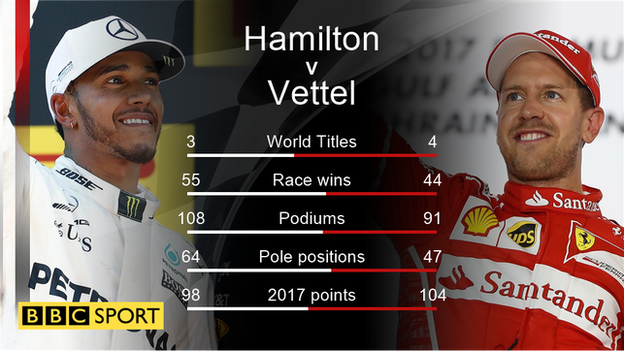
Later in the race, Hamilton found himself behind Vettel but on a faster tyre. Overtaking is notoriously difficult on this track.
After being barged off the track as they disputed the lead when Vettel returned to the track from his final pit stop, Hamilton spent six laps tracking Vettel closely while they negotiated traffic, before using the extra grip of his tyres to get him close enough to use the DRS overtaking aid - now Vettel did not also have it - to blast past on the straight.
It was still asking a lot to make his 'soft' tyres last the 30 laps required to finish the race but he played the life out with excellent judgement, extended his gap, and when Vettel tried to close in again in the final laps, posted the fastest lap of the race with two to go to emphasise how much he was in control.
"What I loved about the race with Sebastian is I love tennis and I love watching [Roger] Federer and [Novak] Djokovic in the final and what I really admire is consistency," said Hamilton.
"I admire their concentration and how they are so awesome and stay at the limit. I felt I had that battle. That is the only way I can explain it."
A bit of needle
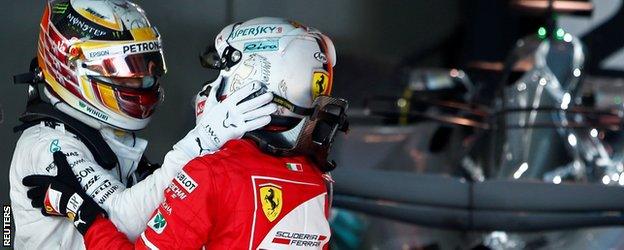
The rivalry between Hamilton and Vettel started at the first race in Melbourne, with the German coming out on top...
During the race, Hamilton had told his team that Vettel's defence of the lead when they came together at Turn One on lap 38 was "dangerous".
Afterwards, they had a brief chat in the pre-podium room. "I didn't say anything bad, just, 'be careful, that was very, very, very close'," said Hamilton.
"But I enjoyed it and I'm glad I was able to have a battle, didn't damage anything and there's nothing lost between us. The respect stays the same.
"He was tough and hard, just to the edge and no more - if he'd hit me that would have been a bit different."
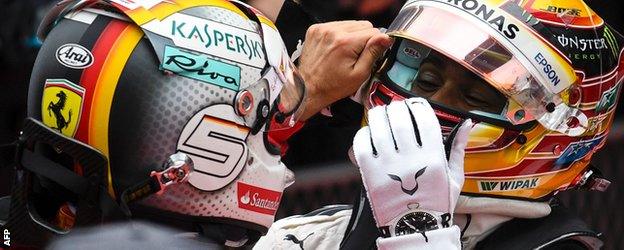
...before Hamilton struck back with a win in China
The respect will doubtless stay through the season no matter what happens, the two men have too much regard for each other's talent for it not to. But this is turning into a titanic scrap between two of the greatest drivers of their generation and it is not hard to imagine that the spiciness is going to go up a few notches as the season goes on.
Hamilton kept his counsel after the race not only because he acknowledged that Vettel had not done anything wrong but also because he knows full well he would have done the same himself.
This was the first intense mano-a-mano combat between the two on track this year, but it's unlikely to be the last. One suspects Hamilton will be more than happy to return the favour if the roles are reversed next time.
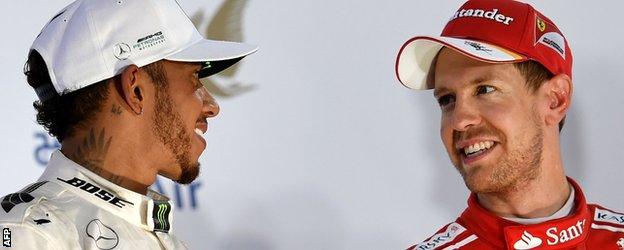
After five races there is still a lot of respect between the two drivers - can it survive a championship battle?
A collective triumph, too
Good as Hamilton's drive was - undoubtedly one of his very best - he could not have done it without a superb collective effort from Mercedes team, from head of strategy James Vowles and Hamilton's engineer Peter Bonnington on the pit wall to his team-mate Valtteri Bottas.
In Bahrain, Mercedes were caught flat-footed on strategy, taking far too long to move Bottas out of Hamilton's way, and it arguably cost them a strong chance of victory. In Barcelona, though, they got everything perfect.
Track position is so important at Spain's Circuit de Barcelona-Catalunya that Hamilton, who started on pole position, already knew he was in for a tough afternoon from the moment he was passed by Vettel on the run down to the first corner.
But he managed to hang on to within about 2.5 seconds of Vettel, despite the fact that until this weekend the Mercedes drivers have tended to lose more performance in the dirty air behind other cars than the more-flexible Ferrari.
Holding that margin was critical, because it forced Ferrari to pit Vettel early in the first stint to avoid the risk of being 'undercut' by Hamilton - when a team stops first and uses the extra grip of new tyres to gain enough time on the driver who stops second to be ahead when both stops are finished.
That done, Mercedes then adjusted their strategy to run a longer first stint - a full seven laps longer than Vettel - and then pit for the harder 'medium' tyres.
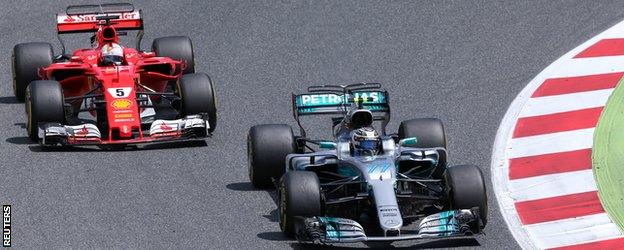
Hamilton's victory was in part down to team-mate Valtteri Bottas, who held Vettel up for two laps before being passed
Mercedes then left Bottas out even longer than Hamilton, and used him strategically to block Vettel who was closing fast on the old-tyred Mercedes on his fresh tyres. It only took Vettel two laps to pass the Finn, despite his valiant defence, but in that time he lost nearly five seconds to Hamilton.
Mercedes' decision to run Hamilton long in the first stint and then fit medium tyres turned out to be critical. In theory, depending on how things worked out, Hamilton could now run to the end on those tyres.
This meant that when the virtual safety car was deployed mid-race following a collision between Felipe Massa's Williams and Stoffel Vandoorne's McLaren, Ferrari could not risk pitting Vettel because it would have put him behind Hamilton. The German's tyres would have been fresher, but of the same compound, and there was no guarantee he would have been able to pass over the rest of the race.
That freed up Mercedes to make the strategy call that won Hamilton the race. To avoid Ferrari responding, they waited until it was clear the VSC period was about to end before pitting Hamilton for fresh tyres.
The fact that some of his pit stop was done while Vettel was being controlled to VSC speeds meant the Ferrari driver's lead was cut from eight seconds to nothing and they were side by side as Vettel emerged from the pits and they headed to the first corner.
That's 12 seconds Mercedes bought Hamilton in his battle with Vettel by two clever strategic plays.
Hamilton very nearly took the lead there and then, only to be barged aside. But he bided his time on his grippier tyres - he was on the much-faster softs by now and Vettel on the mediums - and got it done a few laps later.
Some progress on the car, too
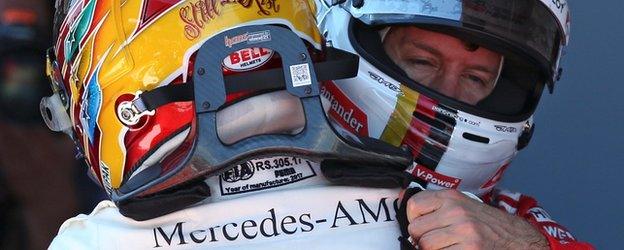
Hamilton and Vettel embraced after the Grand Prix despite what Hamilton described as "tough" racing
The other positive for Hamilton and Mercedes in this race was technical. Not only could Hamilton follow Vettel closely twice, when in previous races that might not have been possible, but the car also had noticeable better tyre usage than in some races this year, despite the hot weather.
Hamilton said he believed the dramatic-looking aerodynamic upgrades on the Mercedes may have been partly responsible for this.
"I was on a different tyre to him at the end, particularly when I was close," he said. "That was a large part of it.
"The upgrades have helped. The experience we've had in the last couple of races, understanding the tyres and where to put them we are starting to see the benefits of that.
"It is still hard to overtake, but it was an unusual weekend where we were quick in the last sector and they were slower but they were very strong in the first two. I was surprised I was able to follow. I can't tell you why but I think ultimately we were quicker today."

Who has won what in the 2017 season so far. Next stop: Monaco
There was actually some debate after the race about whether the Mercedes or the Ferrari was the quicker car in Spain. Hamilton and team boss Toto Wolff both said they thought that was the case; others - including Vettel - believed it was the Ferrari.
What that underlines is just how close this battle is, that races are being decided by the tiniest margins, by strategy, intelligence and driving skills are coming to the fore. Neither team can get away with mistakes - Mercedes made them in Bahrain and lost; Ferrari were out-thought in Spain.
"The car was good, nothing to blame there," Vettel said. "I think our weekend was a bit scrappy overall."
The key to the season
Next comes Monaco, the most prestigious race of the season. Both men will want a win there, but both are aware it is just one more battle in a much longer war.
"In my mind, it is not the most important thing," Hamilton said. "For me it is about consistency. You can get ahead for one race and behind the next.
"It is about trying to perform as I have this weekend every single race we have left. Whoever is the most consistent [will win]."
If he can keep driving as well as he did in Spain, and Mercedes go with him, Hamilton will take some stopping.
- Published14 May 2017
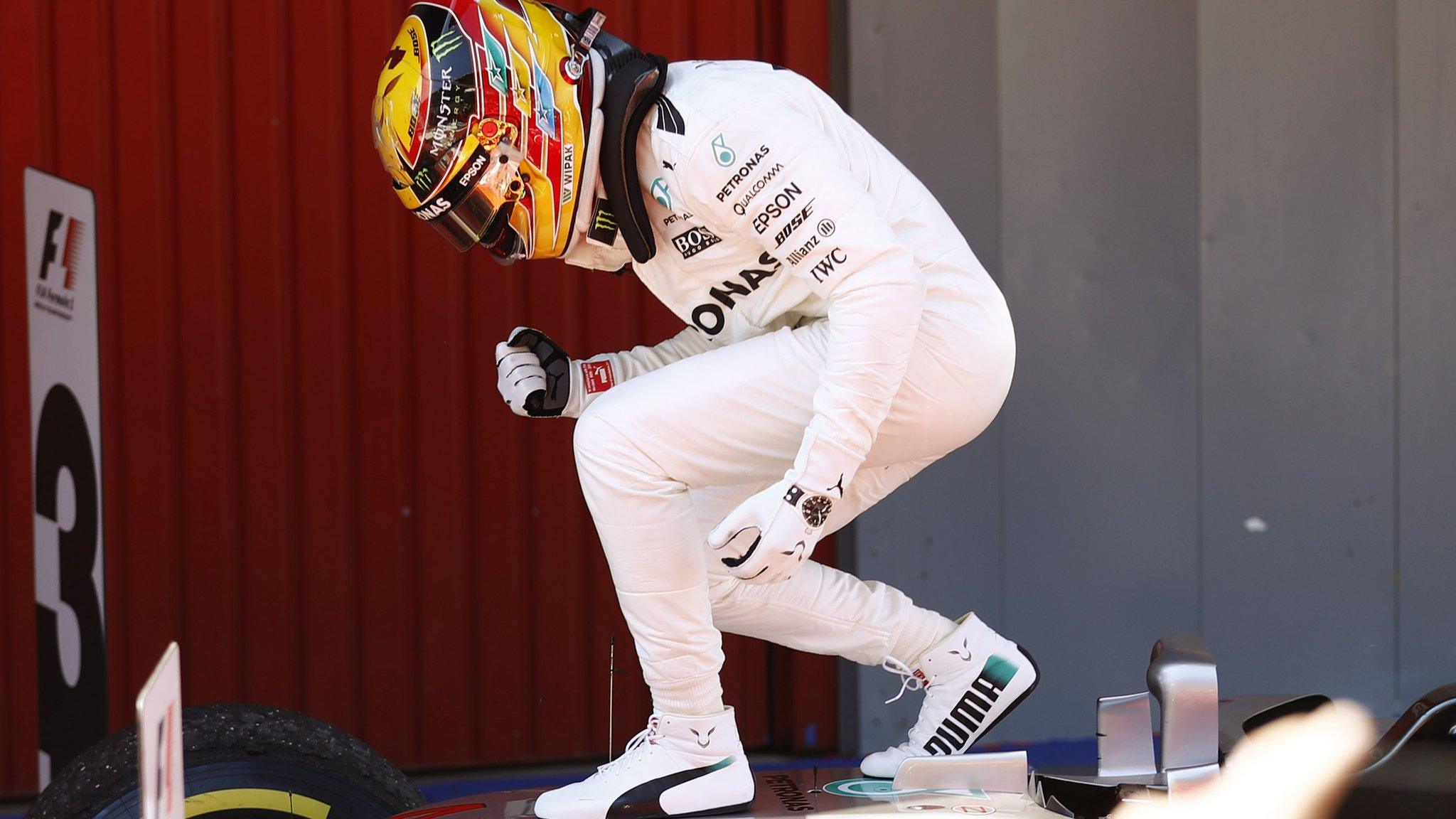
- Published14 May 2017
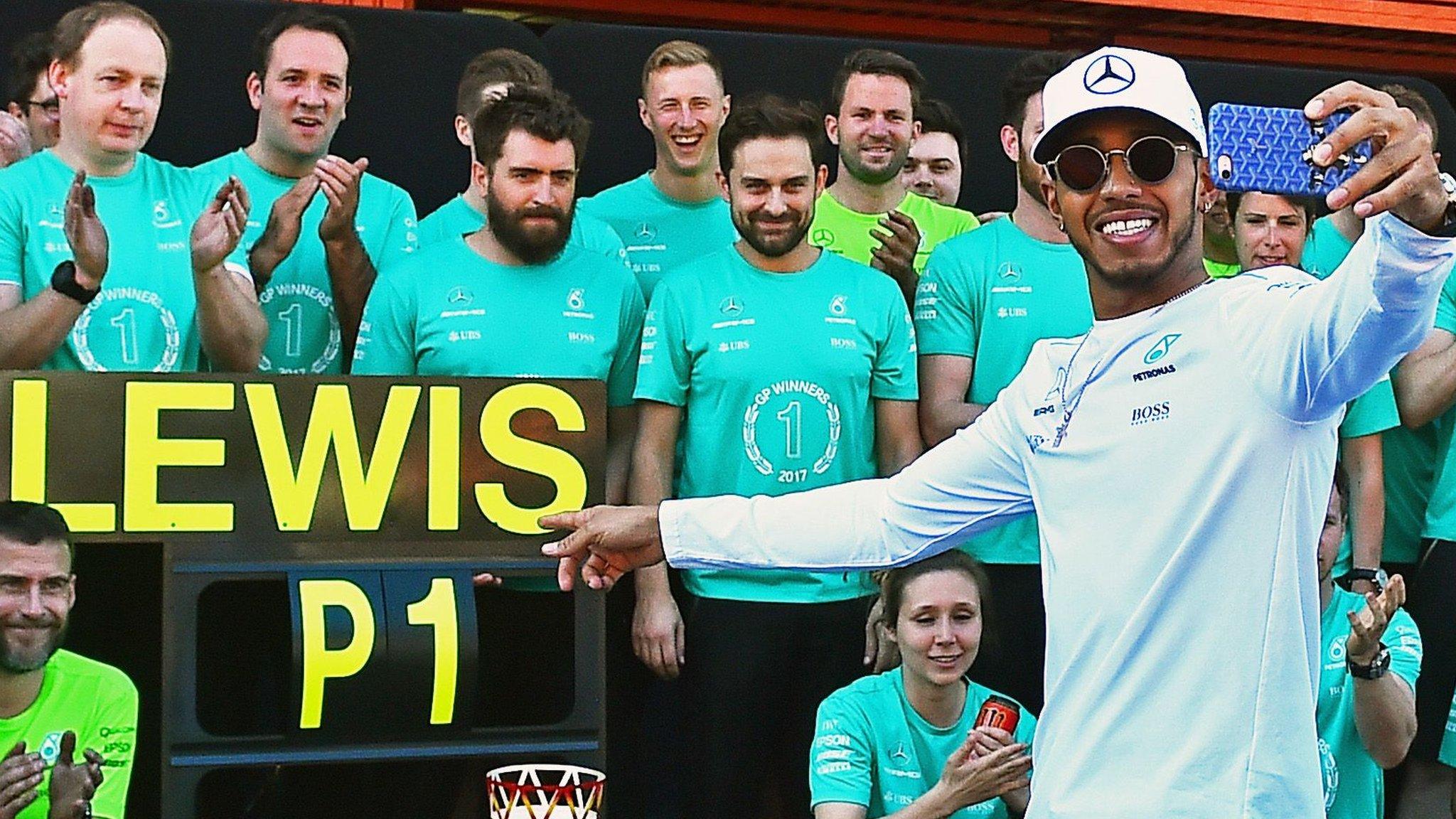
- Published8 May 2017
